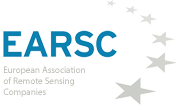Yesterday, we attended the press conference where the European Commission’s and the European Space Agency’s representatives proudly introduced the first images acquired by the radar instrument, providing the possibility of a day and night, all-weather, frequently revised world coverage. As a newcomer to the EO sector I found the imagery very impressive and the images shown gave just a glimpse of the 1.8 terabytes per day that will be collected by Sentinel 1. We recognise that it is a challenge for European institutions and industry to distribute and digest the huge amount of information they bring. Here’s the link for self-registration and download of Sentinel-1A available data provided: http://scihub.esa.int/.
Sentinel-1A, the first Copernicus’ environmental monitoring satellite, has been flying for just one month. It is still in the commissioning phase, but the expectation is so high that everybody is already working hard to show what the basic products coming from its data will look like.
The session was organised with 6 users showing radar applications in the domains of ice and ocean monitoring, maritime surveillance and environmental protection, emergency management and preparedness, climate change and innovative land cover analysis. Present stakeholders all praised especially the high coverage rate of this first EC – ESA radar satellite; which will be increased when Sentinel 1B will fly as well. Some also underlined how the objective of this mission is to provide a global continuous and consistent mapping of the whole planet: this is to complement other national, public or private missions with higher resolution and different characteristics.
The promise is to have a fully operational satellite after the summer 2014. First results open the way for a bright perspective that free and open data will deliver to value-adding companies and end users and some of the potential contribution to future scientific research. SMEs and start-ups, the engine of European growth, will be able to access and exploit this resource. EC and ESA are committed to keep on working for a smooth deployment of the rest of the Sentinel fleet and at EARSC we are also committed to continue to help the industry develop new business from this exciting new data source: the European Copernicus programme.

This page has no comments.